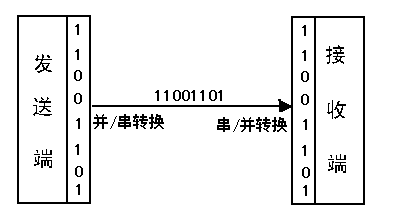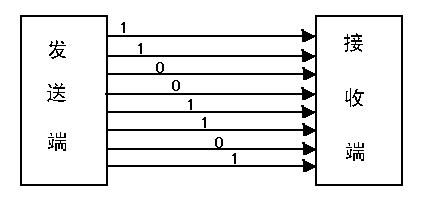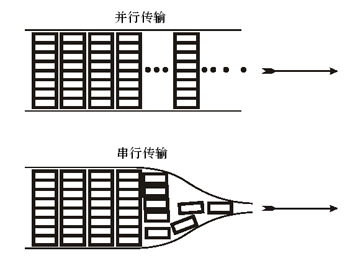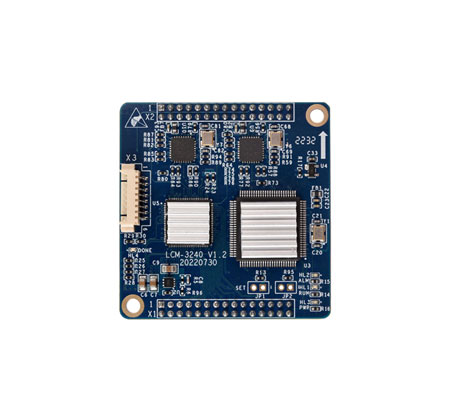1.1 Serial Interface
It is briefly called the serial port, that is, the COM interface, which is an extended interface adopting the serial communication protocol. Common serial ports include:

The so-called serial communication means that the data between reception and transmission is transmitted bit by bit. Taking the transmission of 11001101 as an example, the transmission process is shown in the following figure.

1.1.1 Characteristics of Serial Communication
● Advantages: There are fewer transmission lines. Theoretically, as long as a pair of transmission lines can achieve two-way communication. The connection is simple and the cost is relatively low, making it suitable for long-distance transmission.
● Disadvantages: Since only one bit can be transmitted at a time, the transmission rate is relatively slow.
1.1.2 Classification of Serial Communication
According to different transmission methods, serial communication can be divided into:
● Synchronous communication
● Asynchronous communication
According to the structure of the transmission direction, serial communication can be divided into:
● Simplex
● Half-duplex
● Full-duplex
1.2 Parallel Interface
The parallel interface, briefly called the parallel port, that is, the LPT interface, is an extended interface that adopts the parallel communication protocol. The so-called parallel communication means that each data bit of a group of data is transmitted simultaneously on multiple lines. Taking the transmission of 11001101 as an example again, the parallel communication is shown in the following figure.
The data transmission rate of the parallel port is 8 times faster than that of the serial port. The data transmission rate of the standard parallel port is 1Mbps, and it is generally used to connect printers, scanners, etc. Therefore, the parallel port is also known as the printer port. Parallel communication is fast, but it uses more communication lines and has a high cost, so it is not suitable for long-distance communication. Various internal buses of computers or PLCs transmit data in a parallel manner.

1.2.1 Characteristics of Parallel Interface
● All data bits are transmitted simultaneously, with a high transmission speed and efficiency, and it is mostly used in real-time and fast-paced scenarios.
● It is the most basic way of information exchange in a microcomputer system.
● The information transmitted in parallel does not require a fixed format.
● The data transmission rate of the parallel interface is 8 times faster than that of the serial interface. The theoretical value of the data transmission rate of the standard parallel port is 1Mbps (megabits per second).
● The data width of parallel transmission can be 1 to 128 bits or even wider. However, the number of data lines required is equal to the number of data bits, so the transmission cost is relatively high.
● Parallel communication has poor anti-interference ability.
● Data transmission inside integrated circuit chips, between components on the same plug-in board, and between plug-in boards in the same chassis is all parallel.
● Taking the word length of a computer, which is usually 8 bits, 16 bits, or 32 bits, as the transmission unit, a word length of data is transmitted at a time. It is suitable for short-distance, large-volume, and fast information exchange between external devices and the microcomputer.
● Parallel data transmission is only applicable to short-distance communication, and the transmission distance is usually less than 30 meters.
1.3 Differences between the Serial Port and the Parallel Port
● The serial port can be described as a single lane, while the parallel port is like having 8 lanes that can transmit 8 bits (one byte) of data at the same moment.

● In serial transmission, only one transmission channel is used, and characters are transmitted bit by bit in an orderly manner. The speed of serial transmission is much slower than that of parallel transmission, but the cost is lower.
● Parallel transmission is suitable for short-distance transmission, while serial transmission is suitable for long-distance transmission.
Judging from the situation of technological development, the serial transmission mode shows a strong tendency to completely replace the parallel transmission mode. For example, USB has replaced IEEE 1284, SATA has replaced PATA, and PCI Express has replaced PCI, and so on. However, in terms of principles, the parallel transmission mode is actually superior to the serial transmission mode. Popularly speaking, the pathway of parallel transmission is like a wide multi-lane avenue, while the serial transmission is like a country road that only allows one car to pass through. Taking the ancient and typical Standard Parallel Port and the serial port (commonly known as the COM port) as examples, the parallel interface has 8 data lines and a high data transmission rate; while the serial interface has only 1 data line and a low data transmission speed. In the time it takes for the serial port to transmit 1 bit, the parallel port can transmit one byte. When the parallel port has completed the task of transmitting the word "abcdefgh", only the first letter "a" of this word has been transmitted in the serial port.





